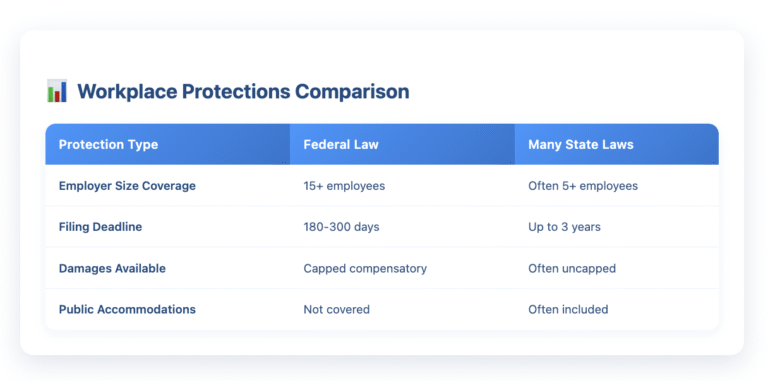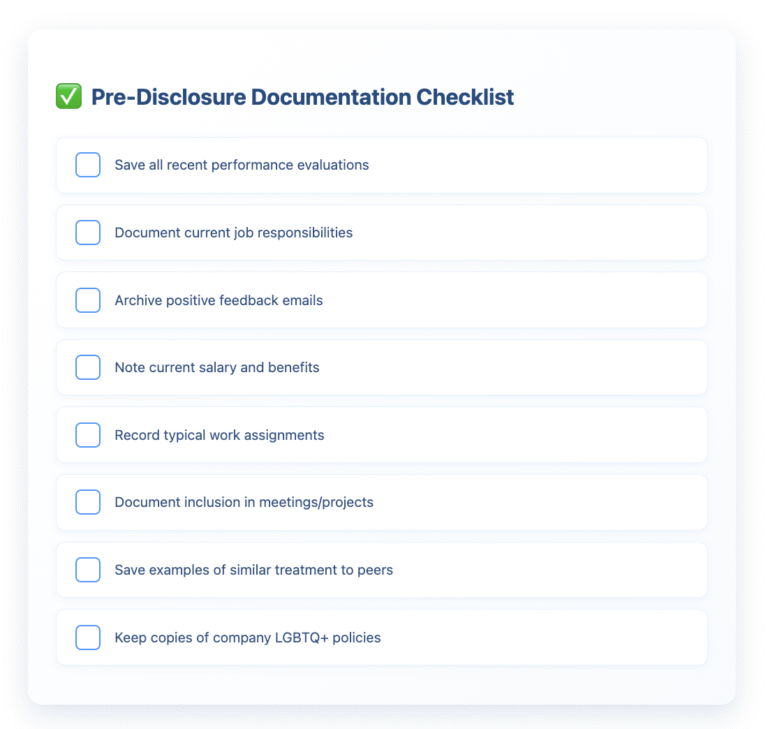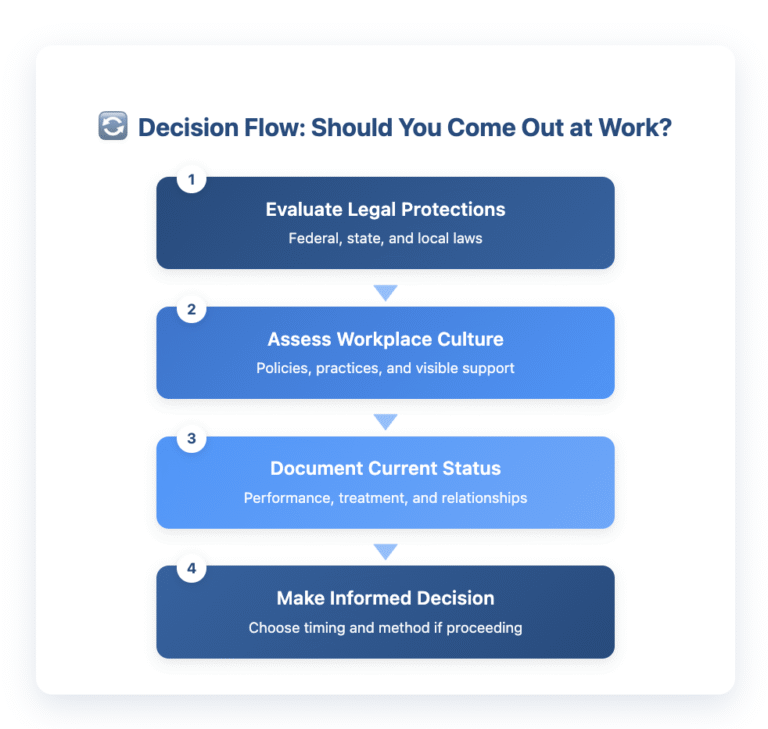Deciding whether to come out at work is one of the most personal decisions you’ll face in your career. It’s also a decision with significant legal implications that many employees don’t fully understand.
The landscape of LGBTQ+ workplace protections has transformed dramatically in recent years, especially after the Supreme Court’s landmark Bostock decision in 2020. But knowing your rights – and understanding how to protect them – requires more than just awareness that discrimination is illegal. You need practical knowledge about privacy rights, documentation strategies, and how to navigate potential backlash while maintaining your legal position.
Disclaimer: This article provides general information for informational purposes only and should not be considered a substitute for legal advice. It is essential to consult with an experienced employment lawyer at our law firm to discuss the specific facts of your case and understand your legal rights and options. This information does not create an attorney-client relationship.
Your Legal Foundation: Understanding Current Protections
Thanks to Bostock v. Clayton County, sexual orientation and gender identity discrimination are now prohibited under Title VII of the Civil Rights Act nationwide. This means your employer cannot legally fire, demote, refuse to hire, or otherwise discriminate against you because you’re LGBTQ+.
But here’s what many people don’t realize: these protections apply whether you’re out or not. You don’t need to formally disclose your sexual orientation or gender identity to be protected from discrimination.
Federal vs. State Protections
While federal law now provides a baseline, many states offer stronger protections. New York, California, and numerous other states had LGBTQ+ employment protections long before Bostock, often with broader coverage and stronger remedies.
These state laws might cover smaller employers (federal law only applies to companies with 15+ employees), provide longer filing deadlines, or allow for greater damages. Understanding your state’s specific protections helps you make informed decisions about disclosure.

Privacy Rights: What You Control
Your sexual orientation and gender identity are personal information. You have the right to control when, how, and to whom you disclose this information at work.
Voluntary Disclosure Principle
No employer can legally require you to disclose your sexual orientation or gender identity. Interview questions about your personal relationships, living situation (beyond legitimate business needs), or LGBTQ+ status violate employment law.
If an employer asks inappropriate questions, document them immediately. These questions themselves can form the basis of a discrimination claim, even if you’re not ultimately denied employment.
Limits to Privacy
While you control your disclosure, understand that coming out to one person at work may affect your privacy expectations. Courts have generally held that once you voluntarily disclose to coworkers, you can’t claim invasion of privacy if that information spreads.
However, there’s a crucial distinction between voluntary disclosure and forced outing. If someone outs you against your will, especially in a malicious manner, this could constitute harassment or create a hostile work environment.
Strategic Considerations Before Coming Out
Assessing Your Workplace Culture
Before making disclosure decisions, evaluate your workplace environment systematically. Look beyond official policies to actual practices.
Review your employee handbook for non-discrimination policies that explicitly include sexual orientation and gender identity. But don’t stop there. Notice how leadership discusses diversity, whether LGBTQ+ employees are visible in leadership roles, and how the company handles other discrimination complaints.
Documentation Before Disclosure
Creating a paper trail before coming out can protect you legally. Save performance reviews, commendations, and positive feedback. Document your good standing before disclosure, as this becomes crucial evidence if your treatment changes afterward.
Email yourself notes about your current relationships with supervisors and colleagues. If discrimination occurs later, you’ll have contemporaneous evidence of the “before” to contrast with the “after.”

The Disclosure Decision: Controlling Your Narrative
Choosing Your Approach
If you decide to come out, you control the method. Some prefer casual disclosure through natural conversation. Others choose formal notification to HR. Neither approach affects your legal protections, but each has strategic implications.
Casual disclosure feels more natural but may lack documentation. Formal disclosure creates a record but might feel unnecessarily official. Consider a middle ground: coming out naturally but following up with an email that references the conversation, creating documentation without awkwardness.
Selective Disclosure Strategies
You don’t have to come out to everyone at once. Many employees successfully maintain different disclosure levels – out to close colleagues but not to clients, or out to your team but not the broader organization.
This approach is legally protected. Your employer cannot force you to be more “out” than you choose, nor can they restrict you from being open about your identity if you prefer.
Navigating Potential Backlash
Recognizing Illegal Responses
After disclosure, stay alert to changes in treatment. Discrimination often appears subtle initially – suddenly increased scrutiny, exclusion from meetings, reassignment of responsibilities, or vague performance concerns.
Document everything, even if it seems minor. Discrimination cases often rely on patterns rather than single dramatic incidents. That “weird vibe” from your supervisor or sudden exclusion from lunch invitations could be legally significant.
Addressing Inappropriate Questions or Comments
Colleagues may respond to your disclosure with inappropriate curiosity or comments. While questions about your personal life aren’t necessarily illegal, they can contribute to a hostile work environment if persistent or intrusive.
You’re not obligated to satisfy anyone’s curiosity. A simple “I prefer to keep my personal life private” or “Let’s focus on work” sets appropriate boundaries. If questions persist, document them and consider reporting to HR.
Religious Exemptions: Know the Limitations
Some employers claim religious exemptions to LGBTQ+ protections. However, these exemptions are narrower than many realize.
Ministerial Exception
Religious organizations can discriminate when hiring ministerial employees – those who perform religious functions. But this doesn’t cover all employees at religious organizations. Janitors, administrators, and others in secular roles generally maintain protection.
Title VII’s Religious Exemption
Religious organizations have some leeway in employment decisions, but courts increasingly limit this when it conflicts with other civil rights. The exemption typically applies to religious preferences, not blanket discrimination against LGBTQ+ individuals.

Using Company Resources
Employee Resource Groups
Many companies have LGBTQ+ employee resource groups (ERGs). These provide community and can offer insights into company culture. Participation is generally a protected activity under employment law.
ERGs can also provide informal guidance about coming out in your specific workplace. Members have navigated this path and can share practical insights about supportive managers or potential challenges.
HR Department Considerations
While HR exists partly to protect the company, they also have obligations to prevent discrimination. Coming out to HR creates a record and may trigger protective measures.
However, remember that HR conversations aren’t always confidential. If you disclose to HR, clarify your expectations about confidentiality and ask about their disclosure policies.
Building Your Support Network
Internal Allies
Identify supportive colleagues before coming out. These allies can provide emotional support and serve as potential witnesses if discrimination occurs.
Look for colleagues who demonstrate LGBTQ+ allyship through actions, not just words. Someone who respects chosen pronouns, challenges discriminatory jokes, or visibly supports LGBTQ+ causes likely offers genuine support.
External Resources
Connect with LGBTQ+ professional organizations in your industry. These groups provide networking, mentorship, and practical advice about navigating workplace disclosure.
Legal advocacy organizations offer resources even before discrimination occurs. Many provide guidance about coming out at work and can connect you with attorneys if issues arise.
Post-Disclosure Protection Strategies
Maintaining Documentation
After coming out, documentation becomes even more critical. Save all performance feedback, track changes in treatment, and note any comments about your LGBTQ+ identity.
Create a timeline of events, even positive ones. This comprehensive record helps establish patterns and refute any claims that performance issues predated discrimination.
Performance Protection
Unfortunately, some employees face heightened scrutiny after coming out. Protect yourself by maintaining impeccable performance and documentation.
Meet all deadlines, follow policies precisely, and document your achievements. While you shouldn’t have to work harder because of your identity, practical protection sometimes requires extra diligence.
When to Seek Legal Counsel
Pre-Disclosure Consultation
Consider consulting an attorney before coming out if you work in a conservative industry, lack clear company protections, or have concerns about potential backlash.
An attorney can review your specific situation, explain applicable laws, and help develop a protective strategy. This proactive approach costs less than defending against discrimination later.
Red Flags Requiring Immediate Action
Certain situations demand immediate legal consultation:
- Direct threats or hostile comments about LGBTQ+ people
- Sudden negative performance reviews after disclosure
- Exclusion from advancement opportunities
- Changes in job responsibilities or compensation
- Any suggestion that you should hide your identity
Special Considerations for Transgender Employees
Transition-Related Accommodations
Transgender employees have additional considerations when coming out, including potential name changes, pronoun preferences, and possible medical transitions.
Employers must respect chosen names and pronouns as part of non-discrimination obligations. Repeated, intentional misgendering can constitute harassment.
Facility Access Rights
Bathroom and locker room access remains contentious but increasingly protected. Federal courts have generally supported transgender employees’ rights to use facilities matching their gender identity.
Document any restrictions or harassment related to facility access. These issues often form strong discrimination claims.
Industry-Specific Considerations
Client-Facing Roles
Employees in client-facing positions sometimes worry about employer concerns regarding customer reactions. However, customer preference never justifies discrimination.
Your employer cannot reassign you, restrict client contact, or otherwise discriminate based on anticipated customer bias. If they express such concerns, document them immediately.
Small Employers
Employees at small companies (under 15 employees) may lack federal protection, but often have state or local coverage. Research your specific protections before making disclosure decisions.
Small workplaces also present unique dynamics. With fewer employees, relationships matter more, but discrimination may be more personally motivated than systemic.
Taking Action: Your Next Steps
Coming out at work remains a deeply personal decision, but it shouldn’t be made without understanding your legal rights and protections. The law increasingly stands with LGBTQ+ employees, but knowing how to leverage these protections requires preparation and strategy.
Document your current situation, research applicable protections, and consider consulting with an attorney before making disclosure decisions. If you face discrimination after coming out, act quickly to preserve your rights.
Your identity shouldn’t limit your career. While the decision to come out at work is yours alone, you don’t have to navigate the legal implications by yourself.
Ready to discuss your workplace rights and create a protection strategy? Contact Nisar Law Group for a confidential consultation. We’ll review your situation, explain your legal protections, and help you make informed decisions about disclosure and documentation. Don’t let uncertainty about your rights keep you from living authentically at work.


